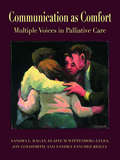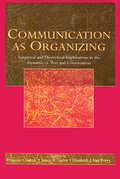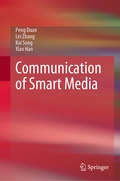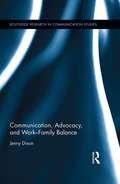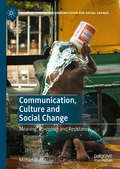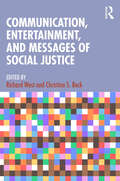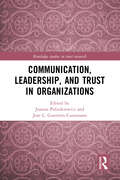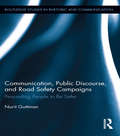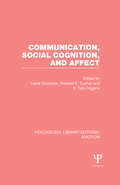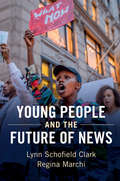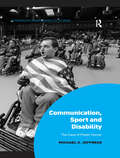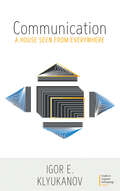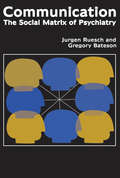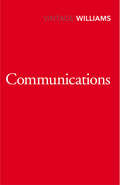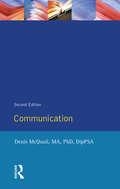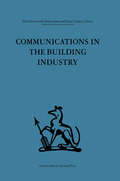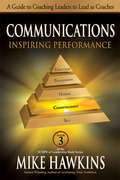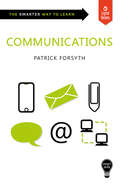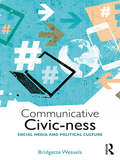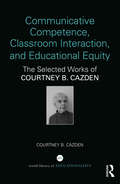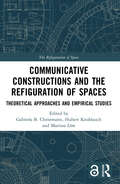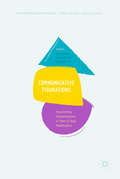- Table View
- List View
Communication and Social Order
by Hugh Dalziel DuncanIn this highly influential study of art forms as models for a theory of communications, Hugh Dalziel Duncan demonstrates that without understanding of the role of symbols in society, social scientists cannot hope to develop adequate models for social analysis. He reviews critically major contributions to communication theory during the past century: Freud's analysis of dream symbolism, Simmel's concept of sociability, James' insights into religious experience, and Dewey's relating of art to experience.
Communication as Comfort: Multiple Voices in Palliative Care (Routledge Communication Series)
by Sandra L. Ragan Elaine M. Wittenberg-Lyles Joy Goldsmith Sandra Sanchez ReillyThis exceptional work explores the complexities of communication at one of the most critical stages of the life experience--during advanced, serious illness and at the end of life. Challenging the predominantly biomedical model that informs much communication between seriously ill and/or dying patients and their physicians, caregivers, and families, Sandra L. Ragan, Elaine M. Wittenberg-Lyles, Joy Goldsmith, and Sandra Sanchez-Reilly pose palliative care--medical care designed to comfort rather than to cure patients--as an antidote to the experience of most Americans at the most vulnerable juncture of their lives. With an author team comprised of three health communication scholars and one physician certified in geriatrics and palliative medicine, this volume integrates the medical literature on palliative care with that of health communication researchers who advocate a biopsychosocial approach to health care. Applying communication theories and insights to illuminate problems and to explain their complexities, the authors advocate a patient-centered approach to care that recognizes and seeks to lessen patients’ suffering and the many types of pain they may experience (physical, psychological, social, and spiritual) during life-threatening illness.
Communication as Organizing: Empirical and Theoretical Explorations in the Dynamic of Text and Conversation (Routledge Communication Series)
by James R. Taylor Elizabeth J. Van Every François CoorenCommunication as Organizing unites multiple reflections on the role of language under a single rubric: the organizing role of communication. Stemming from Jim Taylor's earlier work, The Emergent Organization: Communication as Its Site and Surface (LEA, 2000), the volume editors present a communicational answer to the question, "what is an organization?" through contributions from an international set of scholars and researchers. The chapter authors synthesize various lines of research on constituting organizations through communication, describing their explorations of the relation between language, human practice, and the constitution of organizational forms. Each chapter develops a dimension of the central theme, showing how such concepts as agency, identity, sensemaking, narrative and account may be put to work in discursive analysis to develop effective research into organizing processes. The contributions employ concrete examples to show how the theoretical concepts can be employed to develop effective research. This distinctive volume encourages readers to discover and develop a truly communicational means of addressing the question of organization, addressing how organization itself emerges in the course of communicational transactions. In presenting a single and entirely communicational perspective for exploring organizational phenomena, grounded in the discourse of communicational transactions and the establishment of relationships through language, it is required reading for scholars, researchers, and graduate students working in organizational communication, management, social psychology, pragmatics of language, and organizational studies.
Communication of Smart Media
by Lei Zhang Peng Duan Kai Song Xiao HanThis book provides the readers with an interdisciplinary perspective on communication in the diffuse boundaries that also demonstrates the diversity and inclusion for presenting wide range and rapid changes in contents, and the authors use “smart” as the guiding principle while indicate “communication” has been defined as a core feature. Appropriately, the book is divided into eight major sections. As always, the inevitable result of upgrading and constant iterations of developing new communication technology, the media communication has turned out to be one of the most important means in the smart era. The book sheds new light on virtual reality (VR), a pioneering technology in smart media communication, as an entry point to explore why the core social networks of smart news and smart media communication could occupy the central position in smart media communication while to discuss issues such as platform society built using smart media communication, and further elaborate on the integration of 5G technology, media and social transformation. This book not merely covers disciplines such as journalism and communication, but also on the universal application of smart media communication, and furthermore, it provides practical guidance and reviews cutting-edge ideas. It serves as a good future reference to help scholars, graduate students as well as relevant professionals for thinking outside the box that in order to continually expand reader’s knowledge and professional capabilities, especially aware of the impact of observation and judgment, value analysis and lifelong learning.
Communication, Advocacy, and Work/Family Balance (Routledge Research in Communication Studies)
by Jenny DixonThis book presents an understanding of work-family balance for working adults belonging to a number of different family structures (e.g. single and/or childfree adults, LGBT couples, families with female breadwinners). It contends that family structure should serve as a way of thinking about diversity (i.e., race, gender, age, family) in the U.S. workplace. It also argues that—in addition to accommodations occurring through workplace policy—the negotiation of work-family balance happens as a result of self-advocacy that occurs in everyday communication about family at work. Relaying the stories of a number of different working adults belonging to a variety of different family structures, it explores the range of obstacles faced in the attempt at balancing work and family life, generates informed ideas for eliminating barriers commonly experienced in balancing work and family, and problematizes enduring assumptions regarding gender roles and the myth of steadfast public and private spheres.
Communication, Culture and Social Change: Meaning, Co-option and Resistance (Palgrave Studies in Communication for Social Change)
by Mohan DuttaDrawing on the culture-centered approach (CCA), this book re-imagines culture as a site for resisting the neocolonial framework of neoliberal governmentality. Culture emerged in the 20th Century as a conceptual tool for resisting the hegemony of West-centric interventions in development, disrupting the assumptions that form the basis of development. This turn to culture offered radical possibilities for decolonizing social change but in response, necolonial development institutions incorporated culture into their strategic framework while simultaneously deploying political and economic power to silence transformative threads. This rise of “culture as development” corresponded with the global rise of neo-liberal governmentality, incorporating culture as a tool for globally reproducing the logic of capital. Using examples of transformative social change interventions, this book emphasizes the role of culture as a site for resisting capitalism and imagining rights-based, sustainable and socialist futures. In particular, it attends to culture as the basis for socialist organizing in activist and party politics. In doing so, Culture, Participation and Social Change offers a framework of inter-linkage between Marxist analyses of capital and cultural analyses of colonialism. It concludes with an anti-colonial framework that re-imagines the academe as a site of activist interventions.
Communication, Entertainment, and Messages of Social Justice
by Richard West Christina S. BeckThis edited collection explores the contemporary interplay among three pivotal areas found in cultures around the world: communication, entertainment, and messages of social justice. Each chapter centralizes communication as instrumental in creating mediated messages pertaining to social justice, usually resulting in a more educated audience.Using an accessible writing style, the contributors investigate both classic and contemporary social media, television, film, stage, radio, and podcast productions by employing both qualitative and quantitative methods. Furthermore, through case studies on topics including transphobia, indigenous comedy and drag performance, this book assesses key issues and themes portrayed in contemporary entertainment education. It provides a foundational framework for analysis by utilizing a broad range of theoretical models to explore representations of race, class, gender, advocacy, and pedagogy among others as well as their communication implications.This book will be of interest to scholars and students in the fields of Communication Studies, Popular Culture Studies, Media Studies, Theatre Studies, Social Justice Studies, Sociology, and Psychology.
Communication, Leadership and Trust in Organizations (Routledge Studies in Trust Research)
by Joanna Paliszkiewicz Cusumano, Jose L. GuerreroTrust in communication and leadership is the key to success in business. This book presents and discusses the main issues and challenges posed by communication, leadership, and trust. The first part of the book describes the communication and trust issues, the second part presents the role of trust in leadership, and the third part describes different examples of implementing trust to organizations. Readers will gain from this book theoretical and practical knowledge of communication, leadership, and trust; empirically validated practice regarding trust and its related concepts; and a novel approach for addressing this topic. This book can be used as a toolbox to improve understanding and opportunities related to building trust in organizations and will be especially valuable for students and researchers in the fields of leadership, organizational communication, business ethics, and trust research.
Communication, Public Discourse, and Road Safety Campaigns: Persuading People to Be Safer (Routledge Studies in Rhetoric and Communication)
by Nurit GuttmanThis book discusses the use of communication campaigns to promote road safety, arguing that they need to elicit public discourse on issues pertaining to culture, equity, gender, workplace norms, environmental issues, and social solidarity. Increasingly, new media channels and formats are employed in the dissemination process, making road safety-related messages ubiquitous, and often controversial. Policy makers, educators, researchers, and the public continue to debate the utility and morality of some of the influence tactics employed in these messages, such as the use of graphic images of injury or death, stigmatization (or "blame and shame"), and the use of "black humor." Guttman argues that influencing road safety requires making changes in normative and cultural conceptions of broader issues in society, yet the typical discourse on road safety tends to focus on individual attitudes and practices. The book highlights the importance of social and behavioral theory in communication campaigns on road safety, and critiques the tendency to focus on individual cognition, affect, and risk conceptions rather than on normative, structural, and cultural factors. The volume positions the discourse on road safety as a social issue, and treats road safety behavior as a social activity that directly relates to other public issues, social values, and social policy, while discussing potential uses of social media and participatory approaches. The discussion turns to the role of road safety communication campaigns as part of a democratic process of eliciting public discourse, including how contemporary society could address broader issues of risk and safety.
Communication, Social Cognition, and Affect (Psychology Library Editions: Emotion)
by E. Tory Higgins Lewis Donohew Howard E. SypherOriginally published in 1988, the purpose of this book was to explore the interrelations among communication, social cognition and affect. The contributors, selected by the editors, were some of the best known in their fields and they significantly added to the knowledge of this interdisciplinary domain at the time. In late April 1986 the authors met at a conference centre at the University of Kentucky. They presented first drafts of their chapters and exchanged ideas. Out of these interactions came this book, which has a broad interest across several areas of psychology and communication. While answering a number of questions, the authors also posed others for future examination.
Communication, Social Structure and Development in Rural Malaysia: A Study of Kampung Kuala Bera
by William WilderThis is an important innovative analysis of communication and society in Pahang, West Malaysia, based on fieldwork carried out in Kampung Kuala Bera. Dr Wilder is concerned with communication networks of all kinds as found in a long-established Malay village, including the uses of language, small-scale (kinship and village-based) networks, and higher-level systems (the district and the nation as a whole). Dr Wilder lays particular emphasis on the role of communication in the process of economic development and on administration during a period of rapid and induced social change. His study is prefaced by a detailed historical account of Pahang and a thorough sociological analysis of Kampung Kuala Bera. The ethnography is meticulously detailed; its special contribution includes the first-ever publication of a Malay village genealogy, a systematic account of birth-order names (a major feature of the kinship system), complete figures on marital breakdowns for the whole village population, and an intensive analysis of leadership in its local context. This work will be of value to students of Southeast Asian societies, rural sociology, network studies, economic development, political education and the mass media in third world countries.
Communication, Society and Politics: Social Media and the Rise of Connective Journalism (Communication, Society and Politics)
by Lynn Schofield ClarkYoung People and the Future of News traces the practices that are evolving as young people come to see news increasingly as something shared via social networks and social media rather than produced and circulated solely by professional news organizations. The book introduces the concept of connective journalism, clarifying the role of creating and sharing stories online as a key precursor to collective and connective political action. At the center of the story are high school students from low-income minority and immigrant communities who often feel underserved or misrepresented by mainstream media but express a strong interest in politics and their communities. Drawing on in-depth field work in three major urban areas over the course of ten years, Young People and the Future of News sheds light on how young people share news that they think others should know about, express solidarity, and bring into being new publics and counter-publics.
Communication, Sport and Disability: The Case of Power Soccer (Interdisciplinary Disability Studies)
by Michael S. JeffressSports are ubiquitous in American society, and given their prominence in the culture, it is easy to understand how most youth in the United States face pressure to participate in organized sports. But what does this mean for the hundreds of thousands of Americans who live with one or more physical disabilities and, in particular, those in powered wheelchairs? Located at the intersection of sports and disability, this book tells the story of power soccer - the first competitive team sport specifically designed for electric wheelchair users. Beginning in France in the 1970s, today, over sixty teams compete within the United States Power Soccer Association (USPSA) and the sport is actively played in over thirty countries. Using ethnographic research conducted while attending practices, games, and social functions of teams from across the nation, Jeffress builds a strong case that electric wheelchair users deserve more opportunity to play sports. They deserve it because they need the same physical and psychosocial benefits from participation as their peers, who have full use of their arms and legs. It challenges the social constructions and barriers that currently stand in the way. Most importantly, this book tells the story of some amazing power soccer athletes. It is a moving, first-hand account of what power soccer means to them and the implications this has for society.
Communication: A House Seen from Everywhere (Studies in Linguistic Anthropology #2)
by Igor E. KlyukanovFocusing on the scientific study of communication, this book is a systematic examination. To that end, the natural, social, cultural, and rational scientific perspectives on communication are presented and then brought together in one unifying framework of the semiotic square, showing how all four views are interconnected. The question of whether the study of communication can be considered a unique science is addressed. It is argued that communication is never separate from any object of study and thus we always deal with its manifestations, captured in the four scientific perspectives discussed in the book.
Communication: The Social Matrix of Psychiatry
by Gene Combs Gregory Bateson Jurgen Ruesch Eve C. PinskerThe integration of psychiatry into the mainstream of American society following World War II involved rethinking and revision of psychiatric theories. While in the past, theories of personality had been concerned with the single individual, this pioneering volume argues that such theories are of little use. Instead, the individual must be seen in the context of social situations in which rapid advances in communication technology have brought people closer together, changing their behavior and self-expression. Ruesch and Bateson show that following World War II mass communication and culture have become so pervasive that no individual or group can escape their influences for long. Therefore, they argue that processes of psychoanalysis must now consider the individual within the framework of a social situation. Focusing upon the larger societal systems, of which both psychiatrist and patient are an integral part, they develop concepts that encompass large-scale events as well as happenings of an individual nature. They have outlined this relationship in a unified theory of communication, which encompasses events linking individual to individual, individual to the group, and ultimately, to events of worldwide concern. The term "social matrix," then, refers to a larger scientific system, of which both the psychiatrist and the patient are integral parts. Jurgen Ruesch was professor of psychiatry at the University of California School of Medicine and director of the section of Social Psychiatry at the Langley Porter Neuropsychatric Institute in San Francisco. Gregory Bateson taught at Columbia University, the New School for Social Research, Harvard University, Stanford University, and the University of California, Santa Cruz. Among his books are "Naven", "Steps to an Ecology of Mind, Mind and Nature: A Necessary Unity", "Angels Fear: Towards an Epistemology of the Sacred", and "A Sacred Unity: Further Steps to an Ecology of Mind".
Communications
by Raymond WilliamsWilliams's fascinating investigation into forms of communication as they stood in 1962 - computers, radio, television, printing, photography, film - remains remarkably relevant today. The idea that reality is primary, and that communication of that reality secondary, is debunked - if we take the view that there is life, and then afterwards accounts of it, we degrade art and learning. Communications are, he argues, a major way in which reality is continually formed and changed. This is Williams's compelling introduction to modern means and institutions of communication.
Communications (Aspects of Modern Sociology)
by Denis McQuail, MA, PhD, DipPSAFirst published in 1985. Routledge is an imprint of Taylor & Francis, an informa company.
Communications in the Building Industry: The report of a pilot study
by Gurth Higgin Neil JessopTavistock Press was established as a co-operative venture between the Tavistock Institute and Routledge & Kegan Paul (RKP) in the 1950s to produce a series of major contributions across the social sciences. This volume is part of a 2001 reissue of a selection of those important works which have since gone out of print, or are difficult to locate. Published by Routledge, 112 volumes in total are being brought together under the name The International Behavioural and Social Sciences Library: Classics from the Tavistock Press. Reproduced here in facsimile, this volume was originally published in 1965 and is available individually. The collection is also available in a number of themed mini-sets of between 5 and 13 volumes, or as a complete collection.
Communications/Media/Geographies (Routledge Studies in Human Geography)
by Julie Cupples Kevin Glynn Shaun Moores André Jansson Paul C. AdamsAlthough there are human geographers who have previously written on matters of media and communication, and those in media and communication studies who have previously written on geographical issues, this is the first book-length dialogue in which experienced theorists and researchers from these different fields address each other directly and engage in conversation across traditional academic boundaries. The result is a compelling discussion, with the authors setting out statements of their positions before responding to the arguments made by others. One significant aspect of this discussion is a spirited debate about the sort of interdisciplinary area that might emerge as a focus for future work. Does the already-established idea of communication geography offer the best way forward? If so, what would applied or critical forms of communication geography be concerned to do? Could communication geography benefit from the sorts of conjunctural analysis that have been developed in contemporary cultural studies? Might a further way forward be to imagine an interdisciplinary field of everyday-life studies, which would draw critically on non-representational theories of practice and movement? Readers of Communications/Media/Geographies are invited to join the debate, thinking through such questions for themselves, and the themes that are explored in this book (for example, of space, place, meaning, power, and ethics) will be of interest not only to academics in human geography and in media and communication studies, but also to a wider range of scholars from across the humanities and social sciences.
Communications: Inspiring Performance (SCOPE of Leadership Book Series #3)
by Mike HawkinsGet results through the skillful exchange of information. Third in the “most comprehensive treatment of leadership I’ve ever seen by one author” (Jim Kouzes, coauthor of The Leadership Challenge).Communications: Inspiring Performance describes how to influence people through positive and trustworthy interpersonal communications. Great leaders speak, write, and listen in a manner that connects with people and moves them to action. By learning the competencies of creating compelling content, engaging the audience, and maintaining communication flow, you are able to capture people’s minds and hearts as well as foster the healthy exchange of ideas and information.The SCOPE of Leadership book series teaches the principles of a coaching approach to leadership and how to achieve exceptional results by working through people. You will learn a straightforward framework to guide you in developing, enabling, exhorting, inspiring, managing, and assimilating people. Benefit from the wisdom of many years of leadership, consulting, and executive coaching experience. Discover how to develop the competencies that align consistently with great leadership.
Communications: Smart Skills (Smart Skills)
by Patrick ForsythCommunication is one of the most basic functions in any organization. It transmits ideas, thoughts, information, opinions, and plans between various parts of an organization as well as to external customers or businesses – Its vital importance can never be over emphasized. Yet it can be difficult and communication breakdown is not uncommon. There are several essential elements to making business communications work; these include structure, clarity, consistency, medium, and relevancy and our guide covers those areas within the below chapters: •Essential foundations of success •Preparation •Face-to-face communication •Putting it in writing •Electronic Communication •On your feet •Being persuasive •Negotiating Our Smart Skill guide will enable you to target and convey your information through software, telephone or in-person methods. Regardless of what medium you use, effective communication means your message is received clearly and is understood entirely.
Communicative Civic-ness: Social Media and Political Culture
by Bridgette WesselsCommunicative Civic-ness explores how political culture shapes social media interactions in civic participation, arguing that social media usage is informed by context-specific civil and political culture. Drawing on cutting-edge research, the book develops a new robust theoretical and conceptual framework on civic engagement and participation, comprising: contextual ethos of civic communication; political culture and civic communication; use of social media in private and public spheres; design of social media. It critically addresses issues within the concept of political culture and develops the concept of ‘communicative civic-ness’. This concept seeks to aid a better-informed debate about the capacity of social media to support the pluralistic discussions that underpin deliberative democratic processes. This book appeals to both undergraduate and postgraduate students, as well as academics with an interest in areas including (but not limited to) sociology, political science and media studies. It will also provide useful information and understanding to third sector organisations and policy-makers regarding forms of civic participation.
Communicative Competence, Classroom Interaction, and Educational Equity: The Selected Works of Courtney B. Cazden
by Courtney B. CazdenIn the World Library of Educationalists series, international scholars themselves compile career-long collections of what they judge to be their finest pieces—extracts from books, key articles, salient research findings, major theoretical and/or practical contributions—so the world can read them in a single manageable volume. Readers thus are able to follow the themes and strands of their work and see their contribution to the development of a field, as well as the development of the field itself. Contributors to the series include: Michael Apple, James A. Banks, Joel Spring, William F. Pinar, Stephen J. Ball, Elliot Eisner, Howard Gardner, John Gilbert, Ivor F. Goodson, and Peter Jarvis. In this volume, Courtney B. Cazden, renowned educational sociolinguist, brings together a selection of her seminal work, organized around three themes: development of individual communicative competence in both oral and written language and discourse; classroom interaction in learning and teaching; and social justice/educational equity issues in wider contexts beyond the classroom. Since the 1970s, Cazden has been a key figure in the ethnography of schooling, focusing on children’s linguistic development (both oral and written) and the functions of language in formal education, primarily but not exclusively in the United States. Combining her experiences as a former primary schoolteacher with the insight and methodological rigor of a trained ethnographer and linguist, Cazden helped to establish ethnography and discourse analysis as central methodologies for analyzing classroom interaction. This capstone volume highlights her major contributions to the field.
Communicative Constructions and the Refiguration of Spaces: Theoretical Approaches and Empirical Studies (The Refiguration of Space)
by Gabriela B. ChristmannThrough a variety of empirical studies, this volume offers fresh insights into the manner in which different forms of communicative action transform urban space. With attention to the methodological questions that arise from the attempt to study such changes empirically, it offers new theoretical foundations for understanding the social construction and reconstruction of spaces through communicative action. Seeing communicative action as the basic element in the social construction of reality and conceptualizing communication not only in terms of the use of language and texts, but as involving any kind of objectification, such as technologies, bodies and non-verbal signs, it considers the roles of both direct and mediatized (or digitized) communication. An examination of the conceptualization of the communicative (re-)construction of spaces and the means by which this change might be empirically investigated, this book demonstrates the fruitfulness of the notion of refiguration as a means by which to understand the transformation of contemporary societies. As such, it will appeal to sociologists, social theorists, and geographers with interests in social construction and urban space.
Communicative Figurations: Transforming Communications in Times of Deep Mediatization (Transforming Communications – Studies in Cross-Media Research)
by Andreas Hepp Andreas Breiter Uwe HasebrinkThis book is open access under a CC BY 4. 0 license. This volume is about how to research the influence of our changing media environment. Today, there is not one single medium that is the driving force of change. With the spreading of various technical communication media such as mobile phone and internet platforms, we are confronted with a media manifold of deep mediatization. But how can we investigate its transformative capability? This book answers this question by taking a non-media-centric perspective, researching the various figurations of collectivities and organizations humans are involved in. The first part of the book outlines a fundamental understanding of the changing media environment of deep mediatization and its transformative capacity. The second part focuses on collectivities and movements: communities in the city, critical social movements, maker, online gaming groups and networked groups of young people. The third part moves institutions and organizations into the foreground, discussing the transformation of journalism, religion, politics, and education, whilst the fourth and final part is dedicated to methodologies and perspectives.

